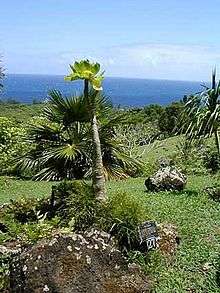Brighamia insignis
| Brighamia insignis | |
|---|---|
| | |
| Scientific classification | |
| Kingdom: | Plantae |
| (unranked): | Angiosperms |
| (unranked): | Eudicots |
| (unranked): | Asterids |
| Order: | Asterales |
| Family: | Campanulaceae |
| Subfamily: | Lobelioideae |
| Genus: | Brighamia |
| Species: | B. insignis |
| Binomial name | |
| Brighamia insignis A.Gray | |
Brighamia insignis, commonly known as Ōlulu or Alula in Hawaiian,[2] or colloquially as the vulcan palm[3] or cabbage on a stick,[4] is a critically endangered species of Hawaiian lobelioid in the bellflower family, Campanulaceae. It is native to the islands of Kauaʻi and Niʻihau. This short-lived perennial species is a member of a unique endemic Hawaiian genus with only one other species. It is now extremely rare. In 1994 the United States Fish and Wildlife Service reported five populations totaling 45 to 65 individuals, and listed the plant as an endangered species.
B. insignis is a potentially branched plant with a succulent stem that is bulbous at the bottom and tapers toward the top, ending in a compact rosette of fleshy leaves. The stem is usually 1–2 m (3.3–6.6 ft) in height, but can reach 5 m (16 ft).[5] The plant blooms in September through November.[6] It has clusters of fragrant yellow flowers in groups of three to eight in the leaf axils. The scent has been compared to honeysuckle.[6] Petals are fused into a tube 7 to 14 cm (2.8 to 5.5 in) long. The fruit is a capsule 13 to 19 mm (0.51 to 0.75 in) long containing numerous seeds.[7]
B. insignis is found at elevations from sea level to 480 m (1,570 ft) in mesic shrublands and dry forests that receive less than 170 cm (67 in) of annual rainfall. It grows on rocky ledges with little soil and steep sea cliffs.[5] Associated plants include ʻāhinahina (Artemisia spp.) ʻakoko (Euphorbia celastroides), alaheʻe (Psydrax odorata), kāwelu (Eragrostis variabilis), pili (Heteropogon contortus), kokiʻo ʻula (Hibiscus kokio), ʻānaunau (Lepidium serra), nehe (Lipochaeta succulenta), pokulakalaka (Munroidendron racemosum), and ʻilima (Sida fallax).[7]
According to the U.S. Botanic Garden, its only pollinator was a certain type of now-extinct hawk moth. This has made it all but impossible for B. insignis to reproduce on its own.[8] Therefore, individuals only produce seed when artificially pollinated by humans.[9]
Other threats to the species have included exotic plant species, feral goats and pigs, slugs, rats, fire, and infestations of carmine spider mites (Tetranychus cinnabarinus).[10][11] There is also a hiking trail near one of the populations.[10] The plant grows on steep, exposed cliffs and has been damaged by hurricanes and landslides.[11]
Despite its rarity in the wild it is not hard to cultivate in a nursery,[11] and it has come into use as a novel ornamental plant.[12]
Gallery
- Flowers of the Brighamia insignis
- Flower HawaiianPalm
 An alula plant at Limahuli Garden and Preserve, Kauaʻi.
An alula plant at Limahuli Garden and Preserve, Kauaʻi.
References
- ↑ Bruegmann, M.M. & Caraway, V. (2003). "Brighamia insignis". IUCN Red List of Threatened Species. Version 2013.2. International Union for Conservation of Nature. Retrieved 31 March 2014.
- ↑ McDonald, Marie A.; Paul R. Weissich; Jean Cote (2003). Nā Lei Makamae: the Treasured Lei. University of Hawaii Press. p. 124. ISBN 978-0-8248-2649-9.
- ↑ "Brighamia insignis , Hawaiian palm, Hawaiian vulcan palm, Hawaiian alula, Olulu palm, Cabbage tree, Cabbage on a stick - Shoot". Shootgardening.co.uk. Retrieved 10 January 2016.
- ↑ USDA Plants Profile
- 1 2 "Brighamia insignis". Meet the Plants. National Tropical Botanical Garden. Retrieved 15 November 2009.
- 1 2 Hawaiian Native Plant Cultivation Database. University of Hawaii, Manoa.
- 1 2 "Brighamia insignis". CPC National Collection Plant Profiles. Center for Plant Conservation. 22 July 2008. Retrieved 15 November 2009.
- ↑ "Alula, Olulu" (PDF). Hawaii's Species of Greatest Conservation Need: Process and SGCN Fact Sheets. Hawaii Department of Fish and Wildlife. Retrieved 10 December 2008.
- ↑ James Wong (16 January 2016). "Gardens: all hail the vulcan palm | James Wong | Life and style". The Guardian. Retrieved 11 January 2016.
- 1 2 The Nature Conservancy
- 1 2 3 USFWS. Brighamia insignis Five Year Review. January 18, 2008.
- ↑ National Tropical Botanical Garden
External links
| Wikimedia Commons has media related to Brighamia insignis. |
- "Brighamia insignis". Hawaiian Native Plant Propagation Database. University of Hawaiʻi at Mānoa.
